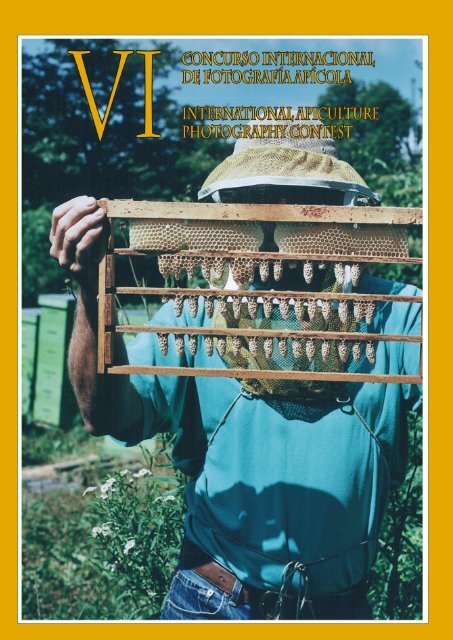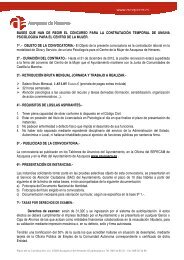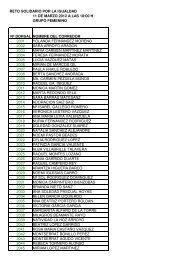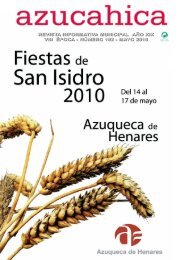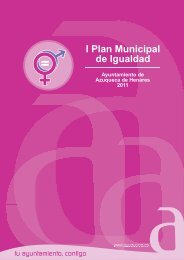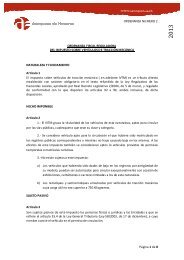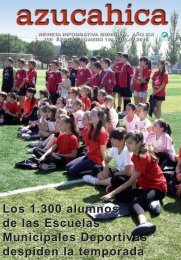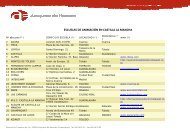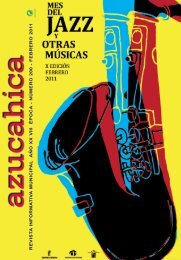VI Concurso internacional de fotografía apícola, 2006, Catálogo
VI Concurso internacional de fotografía apícola, 2006, Catálogo
VI Concurso internacional de fotografía apícola, 2006, Catálogo
You also want an ePaper? Increase the reach of your titles
YUMPU automatically turns print PDFs into web optimized ePapers that Google loves.
- 1 -
<strong>VI</strong> CONCURSO INTERNACIONALDE FOTOGRAFÍA APÍCOLA<strong>VI</strong> INTERNATIONAL APICULTUREPHOTOGRAPHY CONTESTAZUQUECA DE HENARES - GUADALAJARA - ESPAÑA- 3 -
INDICESaluda Sr. Alcal<strong>de</strong> .......................................................................................................... Pág. 9Saluda Sra. Concejala <strong>de</strong> Cultura .................................................................................. Pág. 11Saluda Sr. Concejal <strong>de</strong> Medio Ambiente ..................................................................... Pág. 13El lagar <strong>de</strong> la cera ......................................................................................................... Pág. 15Bases <strong>de</strong> la próxima edición .......................................................................................... Pág. 17Rules for the next edition ............................................................................................ Pág. 18Regles pour la prochaine édition ................................................................................ Pág. 19Relación <strong>de</strong> participantes <strong>2006</strong> .................................................................................... Pág. 20Acta <strong>de</strong>l Jurado <strong>2006</strong> .................................................................................................... Pág. 24Primer Premio: Tibor I. Szabo....................................................................................... Pág. 28Segundo Premio: Zachary Huang ................................................................................ Pág. 30Tercer Premio: Andrei Kochut ...................................................................................... Pág. 32Premio Especial <strong>de</strong> Reportaje: Claire Waring ............................................................. Pág. 34Premio Especial <strong>de</strong> Fotografía Histórica-Artística: Kirsten Traynor ........................... Pág. 38Fotografía Individual1 Chukwu Happiness Ukpa ..................................................................................... Pág. 423 Pavol Ballon.......................................................................................................... Pág. 436 Merce<strong>de</strong>s <strong>de</strong> Badani ............................................................................................ Pág. 448 Makechi W. J. Ashuma ....................................................................................... Pág. 469 Stéphane Bois ...................................................................................................... Pág. 4810 Branko Obranovic ............................................................................................. Pág. 4911 Boštjan Grom....................................................................................................... Pág. 5112 Klaus Nowottnick ............................................................................................... Pág. 5215 Jacek Nowak ...................................................................................................... Pág. 5416 Cosmin Cojocar Mihai ........................................................................................ Pág. 5618 José Luís Gormediano ........................................................................................ Pág. 5821 Marcos Negrete Ocejo ........................................................................................ Pág. 5924 Juan Sebastián Sajama ......................................................................................Pág. 6029 Richard Alvial Flores .......................................................................................... Pág. 6130 Heikki Heinonen ................................................................................................ Pág. 6231 Raúl A. Casanova Ostos ...................................................................................... Pág. 6434 Surendra Raj Joshi .............................................................................................. Pág. 6538 Paco Ayala Rodríguez ....................................................................................... Pág. 6742 Ettamarie Peterson ........................................................................................... Pág. 6843 Javier Pren<strong>de</strong>s Fernán<strong>de</strong>z .................................................................................. Pág. 6946 Antonio Jesús Pérez ........................................................................................... Pág. 7049 Nino Masetti ...................................................................................................... Pág. 7150 Liviu Humeniuc .................................................................................................. Pág. 7251 Belén Ruiz-Roso Martín-Moyano....................................................................... Pág. 7352 Robert Chevet .................................................................................................... Pág. 7456 Delia Manuela.................................................................................................... Pág. 7657 Domingo D. Leveratto ....................................................................................... Pág. 7758 Kirsten Traynor .................................................................................................. Pág. 7959 José Luis Lucas Martín ...................................................................................... Pág. 8160 Felix Herrero García ........................................................................................... Pág. 8264 Ángel Morales Hernán<strong>de</strong>z ................................................................................ Pág. 83- 5 -
INDEXWords from the Mayor ............................................................................................... Page 10Words from Town Councillor of Culture ..................................................................... Page 12Words from Town Councillor of Environment........................................................... Page 14The wax press ................................................................................................................Page 15Bases <strong>de</strong> la próxima edición ......................................................................................... Page 17Rules for the next edition ............................................................................................ Page 18Regles pour la prochaine édition ............................................................................... Page 19Participating relation <strong>2006</strong> .......................................................................................... Page 20Acta <strong>de</strong>l Jurado <strong>2006</strong> ................................................................................................... Page 24Act of the jury <strong>2006</strong> ...................................................................................................... Page 25First prize: Tibor I. Szabo ..............................................................................................Page 28Second prize: Zachary Huang....................................................................................... Page 30Third prize: Andrei Kochut........................................................................................... Page 32Report category prize: Claire Waring ......................................................................... Page 34Historic-Artistic category prize: Kirsten Traynor ......................................................... Page 38Single photographs1 Chukwu Happiness Ukpa .................................................................................... Page 423 Pavol Ballon......................................................................................................... Page 436 Merce<strong>de</strong>s <strong>de</strong> Badani ........................................................................................... Page 448 Makechi W. J. Ashuma ...................................................................................... Page 469 Stéphane Bois ..................................................................................................... Page 4810 Branko Obranovic ............................................................................................ Page 4911 Boštjan Grom.......................................................................................................Page 5112 Klaus Nowottnick .............................................................................................. Page 5215 Jacek Nowak ..................................................................................................... Page 5416 Cosmin Cojocar Mihai ....................................................................................... Page 5618 José Luís Gormediano ....................................................................................... Page 5821 Marcos Negrete Ocejo ....................................................................................... Page 5924 Juan Sebastián Sajama ..................................................................................... Page 6029 Richard Alvial Flores ......................................................................................... Page 6130 Heikki Heinonen ............................................................................................... Page 6231 Raúl A. Casanova Ostos ..................................................................................... Page 6434 Surendra Raj Joshi ............................................................................................. Page 6538 Paco Ayala Rodríguez ...................................................................................... Page 6742 Ettamarie Peterson .......................................................................................... Page 6843 Javier Pren<strong>de</strong>s Fernán<strong>de</strong>z ................................................................................. Page 6946 Antonio Jesús Pérez .......................................................................................... Page 7049 Nino Masetti ...................................................................................................... Page 7150 Liviu Humeniuc ................................................................................................. Page 7251 Belén Ruiz-Roso Martín-Moyano...................................................................... Page 7352 Robert Chevet ................................................................................................... Page 7456 Delia Manuela................................................................................................... Page 7657 Domingo D. Leveratto ...................................................................................... Page 7758 Kristen Traynor ................................................................................................. Page 7959 José Luis Lucas Martín ...................................................................................... Page 8160 Felix Herrero García .......................................................................................... Page 82- 7 -
Por tercer año consecutivo, el Ayuntamiento <strong>de</strong> Azuqueca <strong>de</strong> Henares, a través <strong>de</strong> susconcejalías <strong>de</strong> Cultura y Medioambiente, recopila en un catálogo las mejores instantáneaspresentadas al <strong>Concurso</strong> Internacional <strong>de</strong> Fotografía Apícola, que este año cumple ya susexta edición.En sus páginas tendremos la oportunidad <strong>de</strong> disfrutar <strong>de</strong> imágenes actuales e históricas,provenientes <strong>de</strong> más <strong>de</strong> una treintena <strong>de</strong> países, en las que se muestra la relación <strong>de</strong>lhombre con la actividad <strong>apícola</strong>, su interacción con el medioambiente, su actitud <strong>de</strong>respeto hacia la naturaleza.Y <strong>de</strong> eso es, en <strong>de</strong>finitiva <strong>de</strong> lo que se trata: <strong>de</strong> disfrutar <strong>de</strong>l entorno natural fundiéndosecon él; <strong>de</strong> convertir esa relación natural en arte a través <strong>de</strong> estas magníficas <strong>fotografía</strong>s y<strong>de</strong> recopilarlas en un libro para nuestro disfrute y el <strong>de</strong> las generaciones veni<strong>de</strong>ras.Des<strong>de</strong> el Ayuntamiento <strong>de</strong> Azuqueca <strong>de</strong> Henares venimos apostando <strong>de</strong>s<strong>de</strong> hace añospor la educación ambiental y la labor que se realiza <strong>de</strong>s<strong>de</strong> el Aula Apícola Municipal así lo<strong>de</strong>muestra. Apostamos por transmitir el respeto a la naturaleza <strong>de</strong>s<strong>de</strong> la edad escolarporque queremos que las generaciones futuras here<strong>de</strong>n el planeta en las mejorescondiciones posibles, pero también que el planeta here<strong>de</strong> unas generaciones futuras quehayan interiorizado los valores <strong>de</strong>l <strong>de</strong>sarrollo sostenible.Esperamos que estas <strong>fotografía</strong>s nos ayu<strong>de</strong>n a recordar nuestro vínculo natural con elmedioambiente.Florentino García BonillaAlcal<strong>de</strong> <strong>de</strong> Azuqueca <strong>de</strong> Henaresalcaldia@azuqueca.net- 9 -
La tercera edición <strong>de</strong>l catálogo recopilatorio <strong>de</strong> las mejores instantáneas presentadas al<strong>Concurso</strong> Internacional <strong>de</strong> Fotografía Apícola nos ofrece la oportunidad <strong>de</strong> recordar laíntima relación que existe entre Cultura y Medioambiente.Artes como la pintura primero y la <strong>fotografía</strong> <strong>de</strong>spués se han fijado en la naturalezacomo fuente <strong>de</strong> inspiración a lo largo <strong>de</strong> los siglos. El Certamen Internacional <strong>de</strong> FotografíaApícola pone <strong>de</strong> manifiesto que la naturaleza continúa inspirando a los artistas y paracomprobarlo no hay más que repasar las cifras que ofrece este concurso: cada año se superanlos participantes <strong>de</strong>l anterior, cada edición se suman nuevos países <strong>de</strong>s<strong>de</strong> los que recibimos<strong>fotografía</strong>s, cada certamen disponemos <strong>de</strong> visiones novedosas <strong>de</strong> la apicultura y <strong>de</strong> técnicasfotográficas que consiguen mostrarnos los secretos mejor guardados <strong>de</strong>l mundo natural.Las <strong>fotografía</strong>s recopiladas en este libro son un guiño <strong>de</strong> complicidad a la apiculturaporque le <strong>de</strong>vuelven el favor <strong>de</strong> haber sido fuente <strong>de</strong> inspiración <strong>de</strong> artistas durantegeneraciones. La naturaleza es una gran obra <strong>de</strong> arte y este libro ha conseguido atraparparte <strong>de</strong> ella en sus páginas.Oti Sánchez ChicoConcejala <strong>de</strong> Culturacultura@azuqueca.net- 11 -
Un año más tengo el honor <strong>de</strong> presentar el catálogo con las fotos seleccionadas <strong>de</strong>l <strong>VI</strong><strong>Concurso</strong> Internacional <strong>de</strong> Fotografía Apícola.Observando su marcha, creo que po<strong>de</strong>mos sentirnos orgullosos <strong>de</strong> la evolución <strong>de</strong> este concurso.En cada convocatoria se han presentado más trabajos, <strong>de</strong> más países y con temas más variados.Esto significa que nuestro <strong>Concurso</strong> Internacional <strong>de</strong> Fotografía Apícola se consolida comouno <strong>de</strong> los más importantes en su género, y no sólo entre los apicultores sino también entre losfotógrafos aficionados a la apicultura y amantes <strong>de</strong> la naturaleza. Esta feliz conjunción produceresultados brillantes y originales <strong>de</strong> los que todos nos felicitamos.Pero no sólo el <strong>Catálogo</strong> tiene una gran aceptación. La exposición fotográfica resultante<strong>de</strong>l concurso, formada por las cien fotos seleccionadas y que gustosamente compartimos contodos los colectivos que la solicitan, es cada vez más <strong>de</strong>mandada, hasta el punto <strong>de</strong> que esteaño viajará fuera <strong>de</strong> nuestras fronteras.Por otra parte, queremos señalar que para nosotros este año es especial ya que celebramos lainauguración <strong>de</strong> las instalaciones <strong>de</strong>l Ecomuseo Municipal <strong>de</strong> las Apiculturas <strong>de</strong>l Mundo(EMAM), en el que ocupará un lugar protagonista un antiguo lagar <strong>de</strong> cera que se mantuvo enfuncionamiento más <strong>de</strong> un siglo, esto es, <strong>de</strong>s<strong>de</strong> 1870 hasta 1988. Este lagar, proce<strong>de</strong>nte <strong>de</strong>lmunicipio <strong>de</strong> Maranchón, fue cedido generosamente por su propietario, D. Javier TabarneroBueno, al Aula Apícola Municipal, y tras ser <strong>de</strong>smontado pieza a pieza, transportado yreconstruido, podrá ser visitado por todos los ciudadanos en el marco <strong>de</strong>l Ecomuseo Municipal.Otro motivo <strong>de</strong> satisfacción es la celebración por vez primera en Azuqueca <strong>de</strong> Henares <strong>de</strong> lasesión <strong>de</strong> otoño <strong>de</strong> la sociedad Apistoria, que es una asociación sin ánimo <strong>de</strong> lucro y <strong>de</strong> ámbitoeuropeo que tiene entre sus fines la preservación y difusión <strong>de</strong>l patrimonio cultural <strong>apícola</strong>, yque se reúne anualmente en un lugar distinto con el objeto <strong>de</strong> que sus miembros compartan lasexperiencias y trabajos realizados a lo largo <strong>de</strong>l año.Finalmente, queremos aprovechar esta ocasión para dar las gracias a todos los participantesen el concurso <strong>de</strong> <strong>fotografía</strong> <strong>apícola</strong>, e invitarles no sólo a que sigan enviando sus trabajos enfuturas ediciones sino también a que visiten y disfruten <strong>de</strong>l Ecomuseo Municipal <strong>de</strong> lasApiculturas <strong>de</strong>l Mundo (EMAM), buscando entre sus fondos la representación <strong>de</strong> lapluralidad <strong>de</strong> las diversas apiculturas.Victorio Calles LuengoConcejal <strong>de</strong> Medio Ambientemedioambiente@azuqueca.net- 13 -
Plumilla: Ángeles Muñoz ToledoEl lagar <strong>de</strong> la ceraEn 1870 comenzó a funcionar enMaranchón, provincia <strong>de</strong> Guadalajara (España)este lagar <strong>de</strong> cera <strong>de</strong> la empresa “Ceras Tabarnero”que junto con otros tres lagares <strong>de</strong> parecidascaracterísticas hizo <strong>de</strong> Maranchón la capitalindiscutible <strong>de</strong> la extracción y blanqueo <strong>de</strong> lacera <strong>de</strong> abejas en España.Se trata <strong>de</strong> un lagar romano cuya parte másespectacular tal vez sea el brazo <strong>de</strong> palanca, untronco <strong>de</strong> olmo <strong>de</strong> 10,30 metros <strong>de</strong> longitud y1900 Kg <strong>de</strong> peso que pue<strong>de</strong> ejercer sobre elmacho( Pieza <strong>de</strong> arenisca hueca don<strong>de</strong> se vierteel cerón ya fundido) una presión <strong>de</strong>aproximadamente 24 toneladas.Este lagar que fue <strong>de</strong>smontado pieza apieza, transportado y reconstruido enAzuqueca <strong>de</strong> Henares, <strong>de</strong> forma totalmenteoperativa, gracias a la generosidad <strong>de</strong>lpropietario Javier Tabarnero Bueno, quiencedió al Ayuntamiento <strong>de</strong> Azuqueca <strong>de</strong>Henares y al Aula Apícola Municipal el lagar- 15 -The Wax pressIt started working in Maranchón , provinceof Guadalajara (Spain), this wax press owned bythe company «Tabernero wax» tohgether withother three similar wax press ma<strong>de</strong> Maranchónthe main district of bee wax extraction andblockage in Spain.It is a Roman wax press which has a mostspectacular part that is the control lever, a bodyma<strong>de</strong> of elm 10.30 mts long and it weights 1900kg which can press its weight through the male(it is a sandy piece where you pour the meltedwax ) it also has a preasure of 24 tons.This wax press was taken apart piece by pieceand it was brought here to Azuqueca <strong>de</strong> Henaresthanks to the generous owner Mr. JavierTabarnero Bueno, who has hired it to the Townhallin Azuqueca <strong>de</strong> Henares and to the Localbee-keeping classes for the symbolic price of onepeseta.They started to take it to pieces and to bring
BASES<strong>VI</strong>I CONCURSO INTERNACIONAL DE FOTOGRAFÍA APÍCOLALas Concejalías <strong>de</strong>l Medio Ambiente y <strong>de</strong> Cultura <strong>de</strong>l Excmo. Ayuntamiento <strong>de</strong> Azuqueca <strong>de</strong> Henares, por medio <strong>de</strong>l AulaApícola Municipal, convocan el presente concurso <strong>de</strong> <strong>fotografía</strong> <strong>apícola</strong> que se regirá por las siguientesPARTICIPANTES: Podrá participar en el presente concurso cualquier persona física o jurídica <strong>de</strong> cualquier país <strong>de</strong>l mundo.TEMA: El tema a <strong>de</strong>sarrollar será la apicultura en cualquiera <strong>de</strong> sus aspectos, biología, flora, productos, colmenas y colmenares,usos y costumbres, comercio, promoción, arte, etc.Se valorará especialmente el aspecto humano <strong>de</strong> las <strong>fotografía</strong>s <strong>apícola</strong>s.Las <strong>fotografía</strong>s <strong>de</strong>berán ser originales e inéditas.Se establece un apartado especial para las <strong>fotografía</strong>s no inéditas <strong>de</strong> interés histórico o artístico.TÉCNICAS: Todas, incluida la <strong>fotografía</strong> digital, pudiendo presentarse en blanco y negro o color.APARTADOS: Se establecen los siguientes apartados:Foto individual.Reportaje. Para el conjunto <strong>de</strong> tres a cinco fotos con unidad temática.Foto histórica. Para la recuperación <strong>de</strong> fotos no inéditas <strong>de</strong> interés histórico o artístico.PRESENTACIÓN: Las <strong>fotografía</strong>s se podrán presentar:En papel, sin montar y con un tamaño mínimo <strong>de</strong> <strong>fotografía</strong> <strong>de</strong> 13 x 18 cm.En soporte informático, disco flexible, CD etc.Por correo electrónico.El numero máximo <strong>de</strong> fotos por autor será <strong>de</strong> cinco, pudiendo constituir un reportaje o ser <strong>fotografía</strong>s in<strong>de</strong>pendientes.ENVÍO: Se enviarán libres <strong>de</strong> gastos a:<strong>VI</strong>I <strong>Concurso</strong> Internacional <strong>de</strong> Fotografía ApícolaConcejalía <strong>de</strong>l Medio AmbienteExcmo. Ayuntamiento <strong>de</strong> Azuqueca <strong>de</strong> Henares19200 Guadalajara- EspañaLas fotos enviadas por E-mail lo serán a aulaapicola@jet.esCada <strong>fotografía</strong> o reportaje, <strong>de</strong>berá ir acompañada <strong>de</strong> la siguiente información: Titulo <strong>de</strong> la obra, nombre y dirección <strong>de</strong>l autor,numero <strong>de</strong> documento <strong>de</strong> i<strong>de</strong>ntidad, y pequeño currículo <strong>de</strong>l autor o comentario <strong>de</strong> la <strong>fotografía</strong> (<strong>de</strong> 5 a 10 líneas máximo) ydirección <strong>de</strong> E-mail si se tiene.Se hará mención <strong>de</strong>l apartado en que se <strong>de</strong>sea concursar, foto individual, reportaje, o <strong>fotografía</strong> histórica.PLAZO DE PRESENTACIÓN: El plazo <strong>de</strong> presentación será <strong>de</strong>s<strong>de</strong> la publicación <strong>de</strong> las bases hasta el día 30 <strong>de</strong> Abril <strong>de</strong> 2007.JURADO: El Jurado estará compuesto por personal <strong>de</strong> las Concejalías <strong>de</strong> Cultura y <strong>de</strong> Medio Ambiente, y por personas <strong>de</strong> colectivoscon interés en la <strong>fotografía</strong> y en la apicultura, y presidido por el Excmo. Sr. Alcal<strong>de</strong>, o persona en quien <strong>de</strong>legue, siendo su falloinapelable.PREMIOS: Se establecen los siguientes premios:Para <strong>fotografía</strong>s individuales: Primer premio dotado con 600 Euros y diplomaSegundo premio, dotado con 400 Euros y diplomaTercer premio, dotado con 300 Euros y diplomaPara reportaje: Premio único dotado con 600 Euros y diploma.Para <strong>fotografía</strong> histórica: Premio único dotado con 300 Euros y diploma.El importe <strong>de</strong> los premios será neto, <strong>de</strong>scontándose <strong>de</strong>l mismo los gastos <strong>de</strong> transferencia así como las retenciones fiscales establecidaspor ley.FALLO: El fallo <strong>de</strong>l jurado se hará publico el día 22 <strong>de</strong> Mayo <strong>de</strong> 2007, a través <strong>de</strong> los medios <strong>de</strong> prensa, revistas especializadas,Internet, etc. informando a los ganadores directamente.Las <strong>fotografía</strong>s premiadas pasarán a ser propiedad <strong>de</strong>l Excmo. Ayuntamiento <strong>de</strong> Azuqueca <strong>de</strong> Henares, quien podrá requerir elenvío <strong>de</strong> negativos, diapositivas o discos <strong>de</strong> or<strong>de</strong>nador originales <strong>de</strong> las mismas.EXPOSICIÓN: Las <strong>fotografía</strong>s seleccionadas <strong>de</strong> entre las participantes permanecerán expuestas en Azuqueca <strong>de</strong> Henares <strong>de</strong>s<strong>de</strong> el23 <strong>de</strong> mayo al 30 <strong>de</strong> Junio <strong>de</strong> 2007.Esta exposición se mantendrá activa e itinerante hasta el 30 <strong>de</strong> Abril <strong>de</strong> 2008, estando a disposición <strong>de</strong> todos los colectivos interesadosen su exhibición <strong>de</strong> forma gratuita.También se realizará una exposición virtual con las fotos seleccionadas en la web <strong>de</strong>l Aula Apícola Municipal,http://www.aulaapicolazuqueca.comCATALOGO: De las fotos seleccionadas para la exposición se editará un catalogo a todo color en el que junto a cada <strong>fotografía</strong>figurarán los datos <strong>de</strong>l autor y el currículo adjuntado por el mismo. De dicho catalogo, será enviado un ejemplar <strong>de</strong> forma gratuitaa cada participante.DEVOLUCIÓN: Todas las fotos presentadas y que no resulten ganadoras serán <strong>de</strong>vueltas a sus autores <strong>de</strong> forma gratuita una vezacabado el plazo <strong>de</strong> exhibición, siempre que el autor lo solicite al presentar las fotos a concurso.El resto pasarán al archivo <strong>de</strong>l Aula Apícola Municipal con mención expresa <strong>de</strong> la autoría.DIPLOMA: Todos los participantes recibirán diploma acreditativo <strong>de</strong> participaciónLa participación en este concurso supone la plena aceptación <strong>de</strong> estas bases.- 17 -
<strong>VI</strong>I CONCOURS INTERNATIONAL DE PHOTOGRAPHIE APICOLELes conseilleurs <strong>de</strong> culture et d’environnement <strong>de</strong> Azuqueca <strong>de</strong> Henares, a travers l’Ecole municipale d’apiculture, convoquentce concours international <strong>de</strong> photographie apicole qui va se gui<strong>de</strong>r par les règles suivantes :CONCURRENTS: Toute personne physique ou juridique <strong>de</strong> n’importe quel pays du mon<strong>de</strong>.SUJET: Le sujet tournera autour <strong>de</strong> l’apiculture dans quelconque <strong>de</strong> ses aspects, biologie, flore, produits, ruches, usages et coutumes,commerce, promotion, art, etc.L’aspect humain va être spécialement évalué.Les photographies doivent être originales et inédites.On établit une catégorie spéciale pour la récupération <strong>de</strong>s photographies non inédites avec un intérêt historique ou artistique.TECHNIQUES: Toutes. La photographie digitale incluse. La présentation <strong>de</strong>s ouvrages sera en noir et blanc ou couleur.CATEGORIES: On établit les catégories suivantesPhotographie individuelle.Reportage, pour l’ensemble <strong>de</strong> trois a cinq photographies avec unité thématique.Photographie historique, pour la récupération <strong>de</strong> photographies avec intérêt historique ou artistique.PRESENTATION: On pourra présenter les photographies en papier et les mesures <strong>de</strong> 13x18 cm.au minimum, sur un support informatique, pour e-mailLe maximum <strong>de</strong> photographies par auteur sera <strong>de</strong> cinq, et elles pourraient constituer un reportage ou être <strong>de</strong>s photographiesindividuelles.EXPEDITION: Les photographies seront envoyées sans charge a l’adresse suivant.<strong>VI</strong> <strong>Concurso</strong> Internacional <strong>de</strong> Fotografía ApícolaConcejalía <strong>de</strong>l Medio AmbienteExcmo. Ayuntamiento <strong>de</strong> Azuqueca <strong>de</strong> Henares19200 Guadalajara-EspañaLes photographies envoyées pour E-mail seront à aulaapicola@jet.esJoindre à chaque photographie l’information suivante, titre <strong>de</strong> l’œuvre, non et adresse <strong>de</strong> l’auteur, numéro <strong>de</strong> carte d’i<strong>de</strong>ntité oupasseport, un petit curriculum <strong>de</strong> l’auteur, ou commentaire <strong>de</strong> la photographie (5-10 lignes maximun) et E-mail si on possè<strong>de</strong>.A l’extérieur <strong>de</strong> l’enveloppe signalez la catégorie dans la quelle vous participez, Photographie inédite original, reportage ouphotographie historique.DATE DE PRESENTATION: Des la publication <strong>de</strong>s règles du concours au 30 avril 2007.JURY: Une représentation <strong>de</strong>s conseilleurs <strong>de</strong> L’environnement et <strong>de</strong> la culture aussi bien que <strong>de</strong>s collectifs intéressent aux domainesapicoles ou photographiques feront partie du jury et sera présidé pour le Maire ou délégué. La décision du jury ne pourra pas êtreappelée.PRIX: Pour les photographies individuelles: Un premier prix <strong>de</strong> 600 € et diplôme.Un <strong>de</strong>uxième prix <strong>de</strong> 400 € et diplôme, un troisième prix <strong>de</strong> 300 € et diplôme.Pour le reportage : Prix unique <strong>de</strong> 600 € et diplôme.Pour photographie historique: Prix unique <strong>de</strong> 300 € et diplôme.Le montant <strong>de</strong>s prix sera net, les frais <strong>de</strong> virement postal seront décomptes et aussi les retentions fiscales établies pour la loi.RESULTATS: La décision du jury sera publiée le 22 mai 2007 dans <strong>de</strong> magazines spécialises etpar internet. Les gagnants seront informes directement.La Mairie <strong>de</strong> Azuqueca <strong>de</strong> Henares, <strong>de</strong>viendra propriétaire <strong>de</strong>s ouvrages qui on remporte les prix, et pourra <strong>de</strong>man<strong>de</strong>r les négatifs,les diapositives ou les disques d’ordinateur <strong>de</strong>s photographies.EXPOSITION: Les photographies participantes seront exposées dans Azuqueca <strong>de</strong> Henares <strong>de</strong>s le 23 <strong>de</strong> mai jusqu’au 30 Juin 2007.Avec les photographies sélectionnées on fera une exposition itinérante que sera offert gratuitement a tous les collectifs qui soientintéresses dans son exhibition et sera en activité jusqu’au 30 Avril <strong>de</strong> 2008.Avec les photographies sélectionnées on fera aussi une exposition virtuel dans la web http://www.aulaapicolazuqueca.comCATALOGUE: Avec les photographies sélectionnées on éditera un catalogue en couleur dans lequel a cote <strong>de</strong> chaque photographieva figurer les dates <strong>de</strong> l’auteur envoyés par lui.De ce catalogue sera envoyé un exemplaire sans charge a chaque participantREMISE DES OUVRAGES: Toutes les photographies présentées en papier que ne <strong>de</strong>viennent gagnants seront retournées à leursauteurs, sans charge, une fois fini le terme d’exhibition, si l’auteur fait la <strong>de</strong>man<strong>de</strong> au moment <strong>de</strong> la présentation.Le reste <strong>de</strong>viendra part <strong>de</strong> l’archive <strong>de</strong> l’École municipale d’apiculture avec référence a l’auteur.DIPLOME: Tous les participants recevront un diplôme accréditif <strong>de</strong> participation.La participation à ce concours implique l’acceptation <strong>de</strong> la totalité <strong>de</strong> ses règles- 19 -
Nº Nombre Provincia País Nº Apart.Nº Name Province Country Nº Categ.44 Joan Mª LLorens Molne Tarragona España 144-146 Hist.45 Raúl Guillermo Schnei<strong>de</strong>r Entre Ríos Argentina 147-148 Ind.46 Antonio Jesús Pérez Sevilla España 149-153 Ind.47 Eusebio González Álvarez Asturias España 154-158 Ind.48 Mª Carmen Ramo Gragera Guadalajara España 159-161 Ind.49 Nino Masetti Fontan Francia 162-164 Rep.49 Nino Masetti Fontan Francia 165 Hist.50 Liviu Humeniuc Jud. Suceava Rumania 166-170 Rep.51 Belén Ruiz-Roso Martín-MoyanoGuadalajara España 171-175 Rep.52 Robert Chevet Bor<strong>de</strong>aux Francia 176-180 Rep.53 Enrique García Gómez Toledo España 181-183 Rep.54 Tatiana Martins Salamanca España 184 Ind.55 Oscar Martínez Rodríguez Canarias España 185 Ind.56 Delia Manuela Arad Rumania 186-190 Rep.57 Domingo D. Leveratto Buenos Aires Argentina 191-194 Rep.57 Domingo D. Leveratto Buenos Aires Argentina 240 Ind.58 Kristen Traynor Middletown Estados Unidos 195 His.58 Kristen Traynor Middletown Estados Unidos 196-198 Ind.59 José Luis Lucas Martín Salamanca España 199-202 Ind.60 Felix Herrero García Madrid España 203-207 Rep.61 Mª Asun Herrero García Palencia España 208-212 Rep.62 Leonore Grimm Gemuenda Alemania 212-216 Ind.63 Ignasi Solé Carreras Tarragona España 217-219 Ind.64 Ángel Morales Hernán<strong>de</strong>z La Rioja España 220-224 Ind.65 Júlia Hernán<strong>de</strong>z Hernán<strong>de</strong>z Barcelona España 225-229 Rep.66 Claire Waring Northamptonshire Reino Unido 230-234 Rep.67 Elena Alonso Herrero Palencia España 234-236 Ind.68 Jan Dvoracek Dolni Brezany Chequia 236-237 Ind.69 Blanca Dvorackova Dolni Brezany Chequia 238-239 Ind.70 Josdany Gámez Arcíla Yaracuy Venezuela 241-246 Rep.71 Miguel Asensio Segarra Valencia España 247-251 Ind.72 Inmaculada Pereda Pérez Madrid España 252 Ind.73 Tina Long Virginia Estados Unidos 253-254 Ind.74 Víctor Manuel Suárez Pérez Cuba 255 Ind.75 Bernabé Della Mattia Buenos Aires Argentina 256-257 Ind.76 Santiago Pajuelo Torrado Cádiz España 258-261 Ind.77 Santos Alonso Puente Burgos España 262-265 Ind.78 Tibor I Szabo Ontario Canadá 266-270 Ind.79 Jutta Tewes Hagen Alemania 271-274 Ind.80 Ramiro José López Pérez La Coruña España 275-279 Ind.81 Guillermo Jara Rebolledo Maule Chile 280 Ind.82 Gloria Gil Cacho Guadalajara España 281-282 Hist.83 José Acosta Martínez Murcia España 283-284 Ind.84 Juan Denís Martínez González Asturias España 285-288 Ind.85 Ana Ongil Escribano Guadalajara España 289-290 Ind.85 Ana Ongil Escribano Guadalajara España 291-293 Rep.86 Jesús Manuel Crespo Martín Badajoz España 294-296 Ind.87 Daniel Goldberg Buenos Aires Argentina 297-301 Ind.88 Gustavo Lagar Buenos Aires Argentina 302 Ind.89 Jean-Paul Collo Bretagne Francia 303 Ind.90 Pere Font Girona España 304 Ind.- 21 -
Nº Nombre Provincia País Nº Apart.Nº Name Province Country Nº Categ.139 Alberto Mesa San José Uruguay 484-488 Ind.140 Carlos Navas Heras Madrid DEspaña 489-493 Rep.141 Mª Carmen Rufas Gimenez Huesca España 494-498 Ind.142 Rafael Bueno Heras Guadalajara España 499 Ind.143 Jesús Torralba Izuel Huesca España 500-501 Ind.143 Jesús Torralba Izuel Huesca España 502-504 Rep.144 Ana Díaz Benito-H Agüero Madrid España 505-506 Ind.144 Ana Díaz Benito-H Agüero Madrid España 507-509 Rep.145 Reyntjens Jan Antwerpen Bélgica 510-514 Ind.146 Israel I Onyemaechi Abia State Nigeria 515-519 Ind.147 Ana Isabel Santiago Turuelo Zamora España 520-523 Ind.148 Catalina Santiago Turuelo Zamora España 524-528 Rep.149 Susana Martínez González Cantabria España 529-533 Ind.150 Mª Jesús Martínez González Cantabria España 534-538 Ind.151 Mª Esther Ibeas Torres Cantabria España 539-540 Ind.- 23 -
ACT OF THE JURY <strong>2006</strong>In Azuqueca <strong>de</strong> Henares, being the 10 hours of the 8th of May <strong>2006</strong> the qualifying Jury ofthe <strong>VI</strong> INTERNATIONAL APICULTURE PHOTOGRAPHY CONTEST, is constituted, and formedby the following members:Dª. Oti Sánchez Chico. DNI Nº 00.414.32.32-N, Culture Councilor ofAzuqueca <strong>de</strong> Henares City Council, acting like presi<strong>de</strong>nt.D. Víctor Jiménez Torres. DNI Nº 31.443.21-Z, Presi<strong>de</strong>nt of the CulturalAssociation Foto-Flu, Azuqueca <strong>de</strong> Henares.D. Rodolfo Vargas Vargas. DNI Nº 37.717.875, Coordinator of theCouncil of Culture of Azuqueca <strong>de</strong> Henares (Local Council).D. Julián Chimeno González. DNI Nº 1.779.289-D, Association ofBeekeepers of Alcarria and the rest of the areas of Castilla La Mancha.D. Agustín Arias Martínez. DNI Nº 3.065.201, coordinator of the LocalApiculture School, acting as secretary with no vote.After exam and evaluation of the photographs submitted to contest, the following workshave been awar<strong>de</strong>d:First Prize:Title: «Queen cell acceptance»Author: Tibor I. SzaboProce<strong>de</strong>nce: CanadaSecond Prize:Title: «An Asian hive honey bee (Apis cerana) foraging on red butterfly milkweed(Asclepias curassavica)»Author: Zachary HuangProce<strong>de</strong>nce: United StatesThird Prize:Title: «Fresh honey-nectar»Author: Andrei KochutProce<strong>de</strong>nce: UKraniaSpecial Prize for historical photography:Title: «Artist´s Palette of Pollen»Author: Kirsten TraynorProce<strong>de</strong>nce: United StatesSpecial Prize for Illustrated Feature:Title: «Rafter Beekeeping in Cambodia Whith Apis Dorsata»Author: Claire WaringProce<strong>de</strong>nce: United KingdomWith no other issues to <strong>de</strong>bate, the following act is written and signed on the margin in theor<strong>de</strong>r afore mentioned.- 25 -
<strong>VI</strong> CONCURSO INTERNACIONAL DEFOTOGRAFÍA APÍCOLA<strong>VI</strong> INTERNATIONAL APICULTUREPHOTOGRAPHY CONTEST<strong>VI</strong> CONCOURS INTERNATIONAL DEPHOTOGRAPHIE APICOLE- 27 -
PRIMER PREMIO - FIRST PRIZETítulo: Aceptación <strong>de</strong> celdas realesTitle: Queen cell acceptance- 29 -
SEGUNDO PREMIO - SECOND PRIZETítulo: Abeja asiatica (Apis cerana) pecoreando sobre asclepias común (Asclepias syriaca)Title: An Asian hive honey bee (Apis cerana) foraging on red butterfly milkweed(Asclepias curassavica)- 31 -
TERCER PREMIO - THIRD PRIZETítulo: Miel fresca-nectarTitle: Fresh honey-nectar- 33 -
PREMIO ESPECIAL DE REPORTAJEREPORT CATEGORY PRIZETítulo: Colonia <strong>de</strong> Apis Dorsata en una ramaTitle: Apis Dorsata rafter colony- 35 -
Título: Extrayendo la miel con las manosTitle: Extracting honey by handTítulo: Vendiendo la cria en el mercado <strong>de</strong> Siemp ReapTitle: Selling brood in Siemp Reap market- 37 -
PREMIO ESPECIAL FOTOGRAFÍA HISTÓRICA-ARTÍSTICAHISTORIC-ARTISTIC CATEGORY PRIZETítulo: Paleta <strong>de</strong> Artista <strong>de</strong> PolenTitle: Artist´s Palette of Pollen- 39 -
FOTOGRAFÍA INDI<strong>VI</strong>DUALSINGLE PHOTOGRAPHS- 41 -
Título: Abeja en CrocusTitle: Bee in crocus03- PAVOL BALLONNitra - Eslovaquia - SlovakiaProbablemente es muy tar<strong>de</strong> para enviar lasfotos para vuestro concurso fotografico,pero justamente me he enterado hoy…. Almenos lo intento.Probably is too late for sending photos toyour Photography contest, but I have foundinfo just today... So I am at least trying- 43 -
Título: Apicultor peruanoTitle: Peruan beekeeper- 45 -
Título: Productos por transferencia <strong>de</strong> tecnologíaTitle: Technology transfer-products- 47 -
Título: Vuelo nocturnoTitle: The night flight10- BRANKO OBRANO<strong>VI</strong>Ckocevje - Eslovenia - SloveniaNací el 20 <strong>de</strong> marzo en Ljubljana, Eslovenia.Soy apicultor <strong>de</strong>s<strong>de</strong> hace 20 años y actualmentetengo 50 colmenas.Mi hoby es también la macro<strong>fotografía</strong>. La<strong>fotografía</strong> “Vuelo nocturno” está tomadaen mi colmenar pabellón en Kostel.I was born on 20. march 1949 in Ljubljana,SLOVENIA. Iam the Bee-keeper in the last20 years and have now 50 beehives. My hobyis also mackro photography. The photo “thenight flight” was ma<strong>de</strong> in front of myBeehause in Kostel.- 49 -
Título: Abeja en una flor <strong>de</strong> atractivo colorTitle: Bee on rosy coloured flower11- BOŠTJAN GROMVrhnika - Eslovenia - SloveniaSoy Boštjan Grom. Soy <strong>de</strong> Vrhnika -Eslovenia. Tengo 34 años y soy apicultor<strong>de</strong>s<strong>de</strong> hace seis años, tengo 20 colmenas.Hago <strong>fotografía</strong>s <strong>de</strong>s<strong>de</strong> mi 15 cumpleaños,y <strong>fotografía</strong> digital <strong>de</strong>s<strong>de</strong> hace medio año.I’m Boštjan Grom. I am coming from Vrhnika– Slovenia. I’m 34 years old and I’m 6 yearsbeekeeper, I have 20 beehives. Widthphotography I’m work from my 15 birth day,half year width digital photography.- 51 -
Título: Abeja ventilando con la glándula <strong>de</strong>l olor expuestaTitle: A fanning bee whith exposed scent organ- 53 -
Título: Colmenar Barc-KamiannaTitle: Pasieka Barc-Kamianna- 55 -
Título: ApicultorTitle: Beekeeper- 57 -
Título: Transhumancia siglo XXITitle: Moving beehives XXI Centure21- MARCOS NEGRETE OCEJOCantabria - España - SpainLo mismo que hacían nuestros antepasadoscon caballerizas , muchos años <strong>de</strong>spués sesigue haciendo la <strong>de</strong>nominada transhumancia<strong>apícola</strong> . Los medios han cambiado,pero el trabajo humano sigue siendo imprescindible.Estas fotos están tomadas este invierno enAsturias , <strong>de</strong> una transhumancia <strong>de</strong> la montañapalentina a la zona costera . Se pue<strong>de</strong>observar que son unas 450 colmenas transportadasen un trailer y <strong>de</strong>scargadas con untoro mecánico , lo cual no impi<strong>de</strong> que a vecesse tengan que colocar en el colmenar amano .The same as our ancestors did with stables,many years later we still practise what iscalled bee keeping seasonal migration.The ways have changed, but human work isstill essential.These photos were taken last winter inAsturias, it is a bee seasonal migration fromthe mountain in Palencia to the coast. Youcan see that there are about 450 beehivestaken in a truck and unloa<strong>de</strong>d with amachine, this doesn’t mean that sometimeswe have to place the beehives by hand.- 59 -
Título: La unión hace la fuerzaTitle: The union makes the force29- RICHARD AL<strong>VI</strong>AL FLORES<strong>VI</strong>II Region - Chile - ChileTodas trabajando para el bienestar <strong>de</strong> nuestracolmena.Everybody is working for the well-being ofthe behive.- 61 -
Título: Introducción <strong>de</strong> una reina nueva en la colmena, el momento más excitante, ¿quésuce<strong>de</strong>rá?Title: New queen put in hive. The most exciting moment , what will be happen?- 63 -
Título: Colmenas expuestas en la Feria Nacional <strong>de</strong> la mielTitle: Colonies of honeybees being displayed in National Honey Fair34- SURENDRA RAJ JOSHIKathmandu - Nepal - NeppalEsta foto muestra diferentes tipos <strong>de</strong> colmenaspobladas por colonias <strong>de</strong> abejas exhibidasen la Feria Nacional <strong>de</strong> la Miel organizadapor la Asociación <strong>de</strong> ApicultoresNepalíes en el distrito <strong>de</strong> Chitwan, en Nepal<strong>de</strong>l 9 al 16 <strong>de</strong> Enero <strong>de</strong> <strong>2006</strong>. El objetivo <strong>de</strong>esta feria es el <strong>de</strong> promover la apicultura parala generación <strong>de</strong> renta y la mejora <strong>de</strong>l sustentofamiliar, así como facilitar acuerdos entrelos productores, los comerciantes y los consumidores;la exposición <strong>de</strong> miel, <strong>de</strong> otros productos<strong>apícola</strong>s, <strong>de</strong> accesorios y equipamientorelacionado con la apicultura; y para aumentarel conocimiento <strong>de</strong> la actividad <strong>apícola</strong> y<strong>de</strong>l papel <strong>de</strong> las abejas en el mantenimiento<strong>de</strong> la biodiversidad y el incremento <strong>de</strong> productividad<strong>de</strong> las granjas.La feria recibe miles <strong>de</strong> visitantes <strong>de</strong> todaspartes <strong>de</strong> Nepal y es consi<strong>de</strong>rada un hito enla promoción <strong>de</strong>l mercado interior <strong>de</strong> la miely otros productos <strong>de</strong> la abeja.- 65 -This picture shows different types ofbeehives occupied by honeybee coloniesexhibited at National Honey Fair organisedby Nepal Beekeepers Association in Chitwandistrict, Nepal from January 9-16, <strong>2006</strong>. Theobjective of this fair was to promotebeekeeping for income generation andlivelihood improvement throughfacilitating linkages between producers,tra<strong>de</strong>rs and consumers; exhibition of honey,other bee products, accessories an<strong>de</strong>quipment related to beekeeping; and toraise awareness about beekeeping businessand role of honeybees in maintainingbiodiversity and increasing farmproductivity. The fair received thousands ofvisitors from all over Nepal and wasconsi<strong>de</strong>red a milestone event in promotingthe domestic market for honey and otherbee products.
Título: Abeja Km.Title: Bee Km.38- PACO AYALA RODRÍGUEZGranada - España - Spain- 67 -
Título: Abejas en clase 3Title: Bees in the classroom43- JA<strong>VI</strong>ER PRENDES FERNÁNDEZAsturias - España - SpainJornadas <strong>apícola</strong>s en el Colegio Publico "Ramón<strong>de</strong> Campoamor" <strong>de</strong> Gijón. Los alumnos<strong>de</strong> pre-escolar tras haber realizado multitud<strong>de</strong> activida<strong>de</strong>s relacionadas con elmundo <strong>de</strong> la abeja, tales como dibujos, figuritas,recopilación <strong>de</strong> productos... llegarona la charla-<strong>de</strong>mostración; don<strong>de</strong> un especialistaexplicó todo el proceso <strong>de</strong> extracción<strong>de</strong> miel y dos pequeños alumnos participaron<strong>de</strong> la <strong>de</strong>mostración.Days of bee-keeping work at the PublicSchool "Ramón <strong>de</strong> Campoamor" in Gijón.The kin<strong>de</strong>r-gar<strong>de</strong>n pupils after having donea great number of activities related to theworld of bees, such as drawings, figures, thecompilation of products etc… They arrivedat the <strong>de</strong>monstration speech where anexpert explained them all the process of theextraction of honey and two little pupilstook part in the <strong>de</strong>monstration.- 69 -
Título: Colmenar <strong>de</strong>l Obispo <strong>de</strong> la Brigue (Niza-Francia)Title: Apiary of the bishop of tre Brigue (Nize-France)49- NINO MASSETTIMontan - Francia - FranceLa rehabilitación <strong>de</strong>l colmenar <strong>de</strong>l obispo <strong>de</strong> laBrigue, Francia, en el antiguo condado <strong>de</strong> Niza,en el extremo su<strong>de</strong>ste <strong>de</strong> Francia, la importanteproducción <strong>de</strong> miel y <strong>de</strong> cera atrajo a los ososy otros <strong>de</strong>predadores y los apicultores buscaronmétodos <strong>de</strong> <strong>de</strong>fensa para impedir el saqueoy la <strong>de</strong>strucción <strong>de</strong> las colmenas tradicionales.Como en la cordillera Cantábrica y en Asturias,se empezó a construir cercos murales llamadosCa’ D’arbinée (Casas <strong>de</strong> las Abejas).Hemos tenido la suerte <strong>de</strong> encontrar una viejafoto <strong>de</strong> estos colmenares <strong>de</strong> propiedad <strong>de</strong>l obispoy que fue usado principalmente para recogerla cera para fabricar las velas para la iluminación<strong>de</strong> las iglesias <strong>de</strong> la Diócesis <strong>de</strong> Niza.Este colmenar , construido en el año 1612, estuvoen funcionamiento hasta los años 1920pero luego fue abandonado y usado comoabrigo por una reala <strong>de</strong> perros que lo redujerona un estado <strong>de</strong>plorable. Gracias a nuestrointerés, y a los esfuerzos <strong>de</strong> la Asociación Patrimonioy Tradiciones <strong>de</strong> la Brigue este colmenarha sido recientemente rehabilitadocomo un significativo ejemplo <strong>de</strong> la arquitecturarural y <strong>apícola</strong> <strong>de</strong>l pasado.The restore of the Bishop of Brigue’s behivesin France.At the ancient country of Niza, in the South-East in France, the important production ofhoney and bee wax brought bears and otherpredators, so the beekeepers had to find outthe way to protect the beehives so they couldn’tsteal the honey and they couldn’t break thetraditional beehives. The same happened inCantabria and Asturias, so they started to buildwalls called “Ca’D’abrinée” (bee-houses).We have been lucky to find an old pictureof those beehives owned by the Bishopwhere they mainly picked up wax to makecandles to light up the church in Niza.These beehives which were built in 1612 lasteduntil 1920 but after they were abandoned andthey were used as a shelter for dogs whichleft them in a terrible state. Thanks to ourinterest and to the association of the wealthof the Nation and traditions of Brigue thesebeehives have been rebuilt as a significantexample of rural architecture and bee-keepingin the past.- 71 -
Título: Extracción <strong>de</strong> mielTitle: Honey extraction51- BELÉN RUIZ-ROSO MARTÍN-MOYANOGuadalajara - España - SpainEstas <strong>fotografía</strong>s están tomadas enTorremocha <strong>de</strong> Jarama (Madrid) y muestrana “Luís el apicultor” extrayendo la miel <strong>de</strong>las colmenas para su posterior envasado ycomercialización.These photos were taken in Torremocha <strong>de</strong>Jarama (Madrid) and they show “Luis thebee-keeper” taking out honey from thebeehives to bottle and sell it later.- 73 -
Título: Comenar en los Monegros (Aragón-España)Title: Apiary in the Monegros (Aragon-Spain)Título: Comenar (Cortín) en el Valle <strong>de</strong>l Narcea (Asturias-España)Title: Apiary (Cortin) in the Narcea Valley (Asturias-Spain)- 75 -
Título: Este enjambre será míoTitle: This swarm will be of mine57- DOMINGO D. LEVERATTOBuenos Aires - Argentina - ArgentineSoy Ingeniero Agrónomo, Docente enApicultura en la Facultad <strong>de</strong> Ciencias Agrariasy Forestales, Universidad Nacional <strong>de</strong>La Plata.I am a farming engenieer, a bee-keepingteacher at the Science, Farming andForest University, a Nacional University inLa Plata.- 77 -
Título: Contacto tranquiloTitle: The Gentle Touch58- KIRSTEN TRAYNORMiddletown - Estados Unidos - United StatesContacto tranquiloDos abejas se tocan y comunican sobre unpanal. No solamente intercambian comida,sino también información mediante el frotamiento<strong>de</strong> las antenas. Es interesante verlo bien adaptadas que están las abejas a lavida en comunidad compartiendo casa ycomida.The Gentle TouchTwo bees touch and communicate on aframe of honeycomb. Not only do theyexchange food, but they also exchangeinformation by touching their antennae. Itis interesting to watch how well adapted thehoney bees are to communal living, sharingtheir food and their home.- 79 -
Título: El abueloTitle: The grandfather59- JOSÉ LUÍS LUCAS MARTÍNSalamanca - España - SpainEl abuelo y sus operarios realizan su trabajounos rompiendo los panales <strong>de</strong> cera y el otrorecogiéndola.The grandfather and his assistants working,some of them are breaking the honeycombsof wax and the others are picking them up.- 81 -
Título: Abuelo apicultorTitle: Grandfather beekeeper64- ÁNGEL MORALES HERNÁNDEZLa Rioja - España - SpainMiembro <strong>de</strong> la Agrupación FotográficaRiojana <strong>de</strong>s<strong>de</strong> 1995.Obras seleccionadas en concursos nacionalese <strong>internacional</strong>es. Obra premiada SAAB<strong>internacional</strong> año 2000.Primer premio <strong>de</strong> turismo <strong>de</strong> La Rioja año2001 “SODETUR;SA”Obra premiada “Fotosport” año 2002Cuarto premio Turismo <strong>de</strong> la Rioja 2004Primer premio Denuncia Ecológica, CertamenNacional 2003.Segundo premio Internacional <strong>de</strong> FotografíaApícola 2004.A member of the Photography associationfrom Rioja since 1995.Pictures picked out of the National andInternational contests. It was the winner pictureof the International SAAB in the year 2000.Tourists in La Rioja it was the first prize inthe year 2001. SODETUR, S.A.Picture prized Fotosport in the year 2002.Forth prize Tourism in La Rioja year 2004First prize Ecological Complaint. Nationalcontest 2003.Second prize Bee-Keeping InternationalPhotography year 2004.- 83 -
Título: Colmenas mo<strong>de</strong>rnas en el Cerrato (Palencia)Title: Mo<strong>de</strong>rn beehives in the Cerrato (Palencia)67- ELENA ALONSO HERREROPalencia - España - SpainColmenas mo<strong>de</strong>rnas en El Cerrato, Palencia.Despertar primaveral <strong>de</strong> las colmenas en elCerrato (Sur <strong>de</strong> la provincia <strong>de</strong> Palencia)emplazadas en pequeños cerros (<strong>de</strong> ahí elnombre <strong>de</strong> Cerrato) en los que abunda eltomillo, el brezo y el romero.Mo<strong>de</strong>rn beehives in El Cerrato, Palencia.A spring dawn for the beehives in El Cerrato(a village in the south of Palencia), they areplaced in small hills (that is why it is calledCerrato) where there is a lot of thyme, briarand rosemary.- 85 -
Título: BrescaTitle: Natural honeycomb71- MIGUEL ASENSIO SEGARRAValencia - España - SpainFue para mí uno <strong>de</strong> esos momentos que cambiantu vida. Contaba 15 años, cuando leí allápor el 83 el excelente libro <strong>de</strong> Javier Cabezas"Apicultura Práctica (cartilla <strong>de</strong>lcolmenero)" y mi fascinación por el maravillosomundo <strong>de</strong> las abejas ha ido aumentandocon el tiempo.Con el tiempo aprendí a dividir colmenas,sustituir Reinas, alimentar artificialmente,etc. disfrutando <strong>de</strong> un apiario <strong>de</strong> entre 20 a35 colmenas. Simplemente en plan amateur.Des<strong>de</strong> entonces me siento privilegiado tomandodiariamente miel, polen y propolis,gozando con mis visitas al colmenar, instruyendoa mi hijo o en soledad, repartiendobotes <strong>de</strong> miel a mis amigos y conocidos, leyendo,observando y aprendiendo <strong>de</strong> la inteligencia<strong>de</strong> estos asombrosos insectos.It was one of those moments that changeyour life. I was fifteen, in 1983, when I wasreading the excellent book written by JavierCabezas "Practical bee-keeping (a beekeeper’shandbook)" and my amazementfor the marvellous world of bees is growingas time goes by.I learnt to divi<strong>de</strong> beehives, to replaceQueens, to feed them, etc. Enjoying mybeehives which are between 20 and 35. Justlike an amateur. Since then I feel lucky toeat honey pollen and propolis everyday, Ienjoy every visit to the beehives, to reachmy son or even when I go alone, I also enjoygiving jars of honey to my friends, I verymuch enjoy reading, watching and learningfrom the intelligence of these astonishinginsects.- 87 -
Título: También bebenTitle: They also drink76- SANTIAGO PAJUELO TORRADOCádiz - España - Spain- 89 -
Título: Gran humaredaTitle: Large amount of smoke81- GUILLERMO JARA REBOLLEDOMaule - Chile - ChilePareja <strong>de</strong> apicultores en la costa <strong>de</strong> Chile...la <strong>fotografía</strong> connota una gran humaredaacto que se realiza para tranquilizar a lasabejas.A couple of bee-keepers on the coast ofChile.You can see a large amount of smoke in thepicture, this is used to calm down the bees.- 91 -
Título: Trabajo <strong>de</strong> campoTitle: Investigation workContrasta la blancura <strong>de</strong>l traje <strong>de</strong> la investigadorafrente a los atuendos gastados <strong>de</strong>los experimentados apicultores.There is a contrast between the investigator’swhite suit and the worn clothes used by theexperienced bee-keepers.- 93 -
Título: Sobre la cornisaTitle: On the cornice88- GUSTAVO LAGARCapital Fe<strong>de</strong>ral - Argentina - ArgentineNací el 21 <strong>de</strong> Noviembre <strong>de</strong> 1978, <strong>de</strong>s<strong>de</strong> elaño 2000 me <strong>de</strong>dico a la <strong>fotografía</strong> <strong>de</strong> sociales,actualmente estoy cursando la especializaciónen Fotoperiodismo.La foto es un contraluz <strong>de</strong> un panal don<strong>de</strong>quedaron esas abejas buscando un lugarmientras el apicultor veía el panal.I was born the 21st of November in 1978,since 2000 I have been taking pictures ofsocieties, nowadays I am studying to be aPhoto journalist.The picture is a contrast of a honeycombwhere there are some bees looking for aplace to stay while the bee-keeper is lookingat the honeycomb.- 95 -
Título: Sin títuloTitle: No title90- PERE FONTGerona - España - Spain- 97 -
Título: Sin títuloTitle: No title92- PRIKAZSKY PETRKninice - Chequia - Czech Republic- 99 -
Título: TexturaTitle: Texture94- GUSTAVO A. MUÑOZBuenos Aires - Argentina - ArgentineFotógrafo freelance, colaborador en la revistaRolling Stone, diario La Nación, Clarín,revista Estrategas. También Asistente en elStudioWallace (www.studiowallace.com) enproducciones publicitarias. Socio fundador<strong>de</strong> la agencia fotográfica El Estenopo(www.elestenopo.com.ar) <strong>de</strong>dicada a la cobertura<strong>de</strong> recitales tanto nacionales como<strong>internacional</strong>es y reportajes.Los trabajos realizados para el exterior correspon<strong>de</strong>na la agencia Intertopics <strong>de</strong> Alemania,cubriendo eventos <strong>internacional</strong>esque se realizan en Argentina.As a freelance photographer, I colaboratein the magazine Rolling Stone, thenewspaper La Nacion, Clarín, the magazineEstrategas. I am also an assistant in StudioWallace (www.studiowallace.com) for thepublicity agency El Estenopo(www.elestenopo.com.ar) which coversnational and international reports andconcerts. The foreign articles are ma<strong>de</strong> bythe agency Intertopics from Germany, whichcovers the international events that arecelebrated in Argentina.- 101 -
Título: Sin títuloTitle: No title96- JEAN-MICHEL TENTHOREYVaud <strong>de</strong> Suisse - Suiza - SwissApicultor <strong>de</strong>s<strong>de</strong> hace casi treinta años, hesentido el <strong>de</strong>seo <strong>de</strong> inmortalizar mi pasiónpor medio <strong>de</strong> la <strong>fotografía</strong>. He escogido la<strong>fotografía</strong> digital y utilizo una cámara marcaFujifilm.Esta imagen ha sido captada en casa <strong>de</strong> unamigo apicultor. No ha sido modificada.I have been a bee-keeper for nearly thirtyyears. I have had the <strong>de</strong>sire to immortal mypassion through a picture. I have chosen adigital photograph and I have used aFujifilm camera.This image has been taken in one of my beekeeperfriend’s house. It hasn’t beenretouched.- 103 -
Título: Con el ahumador encendidoTitle: With the smoker lighted99- ANTONIO MEDEL IÑIGOGuadalajara - España - SpainNacido en Guadalajara, hace casi 50 años,me gusta cada vez mas la <strong>fotografía</strong>, y es laprimera vez que participo con mis <strong>fotografía</strong>sen un concurso.I was born in Guadalajara, nearly fifty yearsago, I like taking photos more and moreeach time, and it’s the first time I have takenpart in a contest with my photos.- 105 -
Título: Parece una colmena limpia!!Title: It seems a clean beehive!!106- RODOLFO MARTIARENAMisiones - Argentina - ArgentineApicultor aficionado <strong>de</strong>s<strong>de</strong> hace algo mas<strong>de</strong> 10 años, nacido en Dolores, Pcia. <strong>de</strong> BuenosAires, Rep, Argentina el 03,02,1976. Actualmenteme <strong>de</strong>sempeño en mi actividadprincipal como ing. forestal y como apicultoren los ratos libres.Poseo 100 colmenas en Montecarlo, Misiones,zona subtropical don<strong>de</strong> principalmentese trabaja con abeja africanizada.Me <strong>de</strong>dico exclusivamente a la producción<strong>de</strong> miel junto con mi señora y mi hijo queme ayudan (empresa familiar).También he tenido oportunidad <strong>de</strong> transmitirconocimiento a productores por medio<strong>de</strong> cursos <strong>de</strong> capacitación.I have been keen to bee-keeping for morethan 10 years, I was born in Dolores, Paa inBuenos Aires, Argentina, the 3 rd of February1976. Nowadays I am a Forest Engineer andI practise bee-keeping when I am free.I own 100 beehives in Montecarlo, Misionez,it is a subtropical place where we mainlytreat African bees.I am <strong>de</strong>dicated to produce honey with mywife and my son who helps me ( a familyenterprise) I have also had the chance toteach some producers through courses ofcapability.- 107 -
108- STANISLAV PLUTSemic - Eslovenia - SlovenieStanislav Plut nació el 17 <strong>de</strong> marzo <strong>de</strong>1957in Bela Krajina, en la parte sureste <strong>de</strong>Eslovenia. Fue a la escuela primaria enMetlika y a la escuela técnica en Novo Mesto.Su profesión es ingeniero-técnico. Estaempleado en Tovarna kon<strong>de</strong>nzatorjev Iskraen Semi como jefe <strong>de</strong> uno <strong>de</strong> los <strong>de</strong>partamentos<strong>de</strong> producción. Pasó su juventud enel campo. Adora los animales, especialmentelas abejas. La apicultura se ha convertidoen su hobby <strong>de</strong>s<strong>de</strong> los 13 años cuando comenzóa ayudar a su padre, el apicultor, enel colmenar. Con el pasar <strong>de</strong> los años, suhobby se ha extendido hasta 37 colmenas,las cuales están alojadas en colmenas tradicionaleseslovenas. Ha sido presi<strong>de</strong>nte <strong>de</strong> laAsociación <strong>de</strong> Apicultores <strong>de</strong> Semi, durante12 años, y durante 4 años miembro <strong>de</strong>l cuerpoadministrativo <strong>de</strong> la Asociación Eslovena<strong>de</strong> Apicultura. Su hobby es la <strong>fotografía</strong>,especialmente macro<strong>fotografía</strong> <strong>de</strong> abejas enflores. En 2003 participo por primera vez enel concurso <strong>de</strong> <strong>fotografía</strong> <strong>apícola</strong> <strong>de</strong>Apimondia en Ljubljana y gano la medalla<strong>de</strong> bronce. También ha realizado tres exposicionesfotográficas.Stanislav Plut was born on 17th March, 1957in Bela Krajina, south-eastern part ofSlovenia. He atten<strong>de</strong>d primary school inMetlika and technical school in Novo Mesto.His profession is engine-technician. Heis employed in Tovarna kon<strong>de</strong>nzatorjev IskraSemi as a lea<strong>de</strong>r of one of production’s<strong>de</strong>partments. He spent his youth incountrysi<strong>de</strong>. He adores animals, especiallybees. Beekeeping has become his hobby atthe age of 13, when he began helping hisfather, the beekeeper, with the apiary.Through years his hobby has expan<strong>de</strong>d to37 bee-colonies, which are kept intraditional Slovene beehives. He has beenthe lea<strong>de</strong>r of Semi Beekeepers’ Associatonfor 12 years and for 4 years the member ofAdministrative Body of ApiculturalAssociation of Slovenia. His hobby is amateurphotography, especilly macrophotography of bees on flowers. In 2003 heparticipated for the first time on thecompetition for the best photography onApimondia in Ljubljana and won bronzemedal. He has also had three successfulphotographic exhibitions.- 109 -
Título: Sin títuloTitle: No title116- FRANC SI<strong>VI</strong>CLjubljana - Eslovenia - SlovenieProfesión: Ingeniero <strong>de</strong> silviculturaNació en 1940 en Ljubljana, EsloveniaApicultor <strong>de</strong>s<strong>de</strong> 1957Vive en LjubljanaEquipo:Nikon F3 con Mikro-Nikkor 55 y 105 mm.como objetivos mas utilizados.Occupation: Graduate engineer of forestryBorn in 1940 in Ljubljana, SloveniaEngaged in beekeeping since 1957Residing in LjubljanaPhotographic outfit:Nikon F3 whit Mikro-Nikkor 55 and 105 mm.As mostly used lenses.- 111 -
Título: Sin títuloTitle: No title- 113 -
Título: Manos y AbejasTitle: Hands and bees119- JOSÉ ANTONIO DIEGO MURIERASMadrid - España - SpainLas manos que las alimentan y las mimanno tienen porqué escon<strong>de</strong>rse, van al <strong>de</strong>scubiertopara po<strong>de</strong>r recibir mejor y transmitirla energía <strong>de</strong>l agra<strong>de</strong>cimiento.The hands which feed them and look afterthem don’t have to hi<strong>de</strong>, they are naced toreceive better and to transmit the energythat says thank you.- 115 -
126- ANNA CHAMBERSHight Wycombe - Inglaterra - EnglandEn esta al<strong>de</strong>a <strong>de</strong> Kenia las colmenas masbaratas se construyen con los cantaros <strong>de</strong>arcilla <strong>de</strong> fabricación local. Los cantaros seconstruyen para acarrear el agua , pero sontambién un espacio perfecto para alojar unacolonia <strong>de</strong> abejas. Los apicultores se protegencontra la agresividad <strong>de</strong> la Apis melliferascutellata, pero los muchachos <strong>de</strong> la al<strong>de</strong>aobservan sin ninguna protección. La nochees el mejor momento para extraer la mielcuando las abejas están <strong>de</strong> regreso y a salvoen la colmena. Sin electricidad, las lámparas<strong>de</strong> keroseno se utilizan para alumbrar lacocina en la choza <strong>de</strong> barro. Tradicionalmentelos panales se fun<strong>de</strong>n en agua calentadaal fuego y <strong>de</strong>spués se vierte todo en un viejosaco <strong>de</strong> maíz para filtrar. El saco lleno sesujeta con firmeza entre dos largos y fuertespalos y se retuerce filtrándose su contenidofundido. Un método mo<strong>de</strong>rno es el uso<strong>de</strong> un tamiz doble <strong>de</strong> acero inoxidable. Lavaca <strong>de</strong> la familia observa todo con interés.In this Kenyan village cheap hives are ma<strong>de</strong>from locally constructed clay pots. The potsare built to carry water from the stream, butthey also make the perfect cavity for acolony of bees. The beekeepers dresssecurely against the aggressive Apismellifera scutellata honeybee, but thevillage boys watch on unprotected. Nighttime is the best time for extracting thehoney when the honeybee is safely back inthe hive. With no electricity, Kerosene lampsare used to light the mud hut kitchen.Traditionally the comb is melted over waterheated on a fire and then poured into anold maize storage sack for sieving. The fullsack is held tightly between two long, strongbranches and twisted to squeeze and filterits molten contents. A mo<strong>de</strong>rn method is theuse of a stainless steel double sieve. Thefamily cow watches on with interest.- 117 -
Título: Aún vidaTitle: Still life128- CLAUDIO SOTO VARGASConcepción - Chile - ChileEgresado <strong>de</strong> Agronomía <strong>de</strong> la UniversidadAustral <strong>de</strong> Chile. Inicia su trabajo en Apicultura<strong>de</strong>s<strong>de</strong> el año 2002, al realizar su tesis<strong>de</strong> grado en aspectos <strong>de</strong> Calidad <strong>de</strong> la Miel,Origen Botánico y Análisis Sensorial. Actualmentese <strong>de</strong>sempeña en la Fe<strong>de</strong>ración RedApícola Nacional F.G. <strong>de</strong> Chile, organizaciónque agrupa a los medianos y pequeños productores<strong>de</strong>l país. Y las <strong>fotografía</strong>s enviadascorrespon<strong>de</strong>n a visitas realizadas en el marco<strong>de</strong> un proyecto <strong>de</strong> los apicultores <strong>de</strong> la XRegión, en el sur <strong>de</strong>l territorio nacional.He got graduated in Agronomy at theUniversity of Austral, Chile. He startsworking with bees in 2002, when he ma<strong>de</strong>his theory of the aspects of honey qualitybotanical origin and sensorial analysis.FG in Chile, it is an organization that groupsup the small producers from the country.The photographs that I send are some visitsto the X area in the South of the country.- 119 -
Título: Abeja asiática (Apiscerana) recolectando polen en una flor <strong>de</strong> rodo<strong>de</strong>ndroTitle: An Asian hive honey bee (Apis cerana) foraging for pollen on a rhodo<strong>de</strong>ndron flower131- ZACHARY HUANG.Michigan - Estados Unidos - United StatesEl rodo<strong>de</strong>ndro se planta generalmente porsus hermosas flores <strong>de</strong> primavera. Sin embargo,las abejas obtienen el polen y el néctar<strong>de</strong> muchas especies. Foto tomada enTaiwan el 27 <strong>de</strong> Marzo <strong>de</strong> <strong>2006</strong>. CámaraNikon D 70, macro <strong>de</strong> 60mm Nikkor.copyrighted by Zachary Huang.Rhodo<strong>de</strong>ndron is usually planted for itsbeautiful flowers in the spring. However,bees do obtain pollen and nectar from manyspecies. This photo was taken in Taiwan onMarch 28, <strong>2006</strong>. Taken by a Nikon D70,60mm Nikkor macro lense. copyrighted byZachary Huang.- 121 -
Título: Está <strong>de</strong> moda el rojo IITitle: The red is fashionable132- ANTONIO TORRECCILLAEspaña - Spain- 123 -
Título: La araña rosaTitle: The pink spi<strong>de</strong>r137- FERNANDO DE MIGUEL REYMálaga - España - SpainNacido en un pequeño pueblo <strong>de</strong> Soria, traspasar por Madrid y otras ciuda<strong>de</strong>s, vive enel campo <strong>de</strong> los montes malagueños <strong>de</strong>s<strong>de</strong>1983. Apicultor profesional <strong>de</strong>s<strong>de</strong> hace más<strong>de</strong> veinte años, y siempre aficionado a la<strong>fotografía</strong>.He was born in a small village in Soria, aftervisiting Madrid and other cities, he lives atthe country-si<strong>de</strong> near the mountains inMalaga since 1983. He has been aprofessional bee-keeper for more thantwenty years and he has always been fondof photography.- 125 -
Título: Retejando en el colmenarTitle: Replacing roofing in the beeyard140- CARLOS NAVAS HERASMadrid - España - SpainSe cumple el segundo año <strong>de</strong>s<strong>de</strong> mi acercamientoal mundo <strong>de</strong> las abejas y <strong>de</strong>s<strong>de</strong> aquellasprimeras charlas y conversaciones conlos viejos colmeneros, no <strong>de</strong>jo <strong>de</strong> sorpren<strong>de</strong>rme<strong>de</strong> los muchos a<strong>de</strong>lantos en investigacióny practicas <strong>apícola</strong>s.Sin embargo aun me sorpren<strong>de</strong>n mucho máslas arraigadas costumbres que perduran alpaso <strong>de</strong>l tiempo.En aquel día venteado y <strong>de</strong> nubes se recurrióa las típicas caretas , al serrucho, al barro...Todo para preparar el colmenar antes<strong>de</strong> la nueva temporada.It has been two years since I started gettingclose to bees and since I had the firstconversations with old bee-keepers. I can’thelp being surprised with the new ways ofbee-keeping, however I am more surprisedto see that the old ways are still presentnowadays.On the windy and cloudy day we used thetypical masks, a saw mud everything to preparethe beehives before the new seasoncomes.- 127 -
FOTOGRAFÍA HISTÓRICAHISTORIC PHOTOGRAPHS- 129 -
Título: !Que bonita camioneta tenía mi amigo apicultor!Title: What a lovely van had my friend the beekeeper!Título: !Que bonita camioneta tenía mi amigo apicultor!Title: What a lovely van had my friend the beekeeper!- 131 -
Título: Apicultor principianteTitle: Beginer Beekeper98- BUICIUC SIMONABotosani - Rumanía - RomaniaNo importa aunque se empiece por la colmenanúmero 13. Lo importante es tenerabejas tranquilas. La protección se hace innecesaria.Description: Dosn’t matter if it start with the13 hive. Important to have the calm bees.The protection wasn’t necesary.- 133 -
Título:Title: The bear wanted honey...- 135 -


